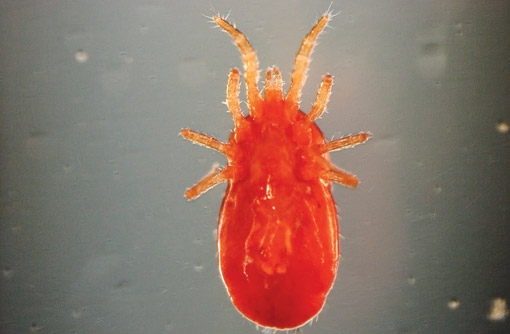New strategies for dealing with red mites on the way

Red mite infestations continue to take their toll on the physical and financial performance of the commercial layer sector, costing the EU industry an estimated £120m a year.
Traditionally, organophosphates, pyrethroids and carbamates have been used to control this stubborn pest. But the mites are developing resistance to these substances.
Combined with the introduction of enriched colony cages, which are more difficult to sanitise, getting rid of red mites is a growing problem.
There is therefore more interest in alternative treatments. Although many of these are still at the developmental stage, it seems that help is on the way for producers struggling to cope with this pest, particularly in the summer months.
Essential oils
A team at Newcastle University has been looking into the possible use of plant-derived oils as alternative insecticides against red mite.
Initially the DEFRA-funded MITEeHEN project compared the toxicity of 50 different essential oils, including products extracted from tea tree oil, manuka, clove buds, garlic, lavender and lemongrass.
The results were impressive, with almost half of the oils proving to kill in excess of three quarters of adult mites within 24 hours of application.
Further testing found that the two most consistent performers were pennyroyal and thyme essential oils.
Up to this stage, all the testing had been done on the laboratory bench. The final stage was a small field study, with hens in huts which were exposed to relatively high levels of the two products. The hens were monitored for feed intake, weight gain, egg production and general health.
Just four weeks into the trial it became apparent that pennyroyal was not suitable, causing increased mortality, weight loss and a fall in egg numbers. However, thyme essential oil exerted good control on mite populations and had no apparent negative side effects on hens, nor was there any taint in their eggs.

“Funding from DEFRA has offered hope to producers with the identification of a promising ‘natural’ acaricide in the form of thyme essential oil, which seems to be harmless to hens, but lethal to red mite,” said Jonathan Guy, senior lecturer at Newcastle University.
“Use of natural oils is now common for many pests of agricultural importance. They work typically by interfering with nervous transmission within the insect.”
Researchers at Northumbria University are also looking into terpenes – the chemical components of essential oils – and marine products as potential acaricides.
Predatory mites
The introduction of predatory insects that prey on parasitic mites might be another way of controlling infestations in stocked sheds.
Early trials suggest certain predatory mites may have the capacity to consume up to five or six red mites a day. However, once the adult population has been killed off, the predatory mites will be without a food source and quickly die out. Thus predatory mites will need to be regularly restocked.
Use of these “natural” predators is quite common in greenhouse crops and there are commercial companies producing predators on a large scale, so the opportunity is real. Laboratory studies have been undertaken at Newcastle University, and also the University of Amsterdam, but as yet the use of predatory mites has not been tested on commercial farms. Despite this, they are available in parts of Europe.
Chitin-synthesis inhibitor
Chitin is a long-chain polymer that acts as the main component in the structure of insect exoskeletons. By disrupting its production, mite growth and reproduction are halted.
By combining the use of a chitin-synthesis inhibitor with a more conventional mite control programme, infestations have been successfully controlled and resistance is less of an issue.
The combination approach employed the carbamate Ficam W (bendiocarb), the pyrethroid OxyFly (lambdacyhalothrin) and the chitin-synthesis inhibitor Baycidal (trifulumuron). The result was between 77% and 99% control of mites.
Keep up with the latest poultry news
